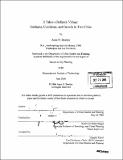| dc.contributor.advisor | Xavier de Souza Briggs. | en_US |
| dc.contributor.author | Bentley, Anna O | en_US |
| dc.contributor.other | Massachusetts Institute of Technology. Dept. of Urban Studies and Planning. | en_US |
| dc.coverage.spatial | n-us-ca n-us-mo | en_US |
| dc.date.accessioned | 2007-05-16T18:42:30Z | |
| dc.date.available | 2007-05-16T18:42:30Z | |
| dc.date.copyright | 2006 | en_US |
| dc.date.issued | 2006 | en_US |
| dc.identifier.uri | http://hdl.handle.net/1721.1/37462 | |
| dc.description | Thesis (M.C.P.)--Massachusetts Institute of Technology, Dept. of Urban Studies and Planning, 2006. | en_US |
| dc.description | Includes bibliographical references (p. 81-85). | en_US |
| dc.description.abstract | The typical stadium development story features a City interested in investing in its future. The City looks to a new ballpark to spark revitalization, provide new jobs and industry, and increase civic pride. Yet, academic research suggests that the City is looking in the wrong place. Economic and even social benefits rarely materialize in quantities sufficient to compensate the City's investment of money, time, and opportunities forgone. Assuming that stadium proponents and local governments behave rationally in their choice to support these projects and that academic research is accurate, a different motive may cause the continued support and interest in new stadium projects. I suggest that what motivates the local governments, interest groups, and private individuals that actively support stadium construction is a central interest in growth. This belief in growth and general development as the desired outcome, rather than specific new jobs or civic pride, may guide the stadium process. Using case study data from San Diego and St. Louis, I examine the stadium planning process, groups involved; motives for participation, and outcomes produced. | en_US |
| dc.description.abstract | (cont.) I then compare the two cases, paying particular attention to evidence of a motivating growth agenda and a new element in these stadium projects - the 'ballpark village' development. My core analysis is prefaced by a review of relevant planning literature, including stadium costs and benefits, growth machine urban theory, equitable development, and community organizing; it is followed by a ruminative consideration of the ballpark village as a stadium development strategy. | en_US |
| dc.description.statementofresponsibility | by Anna O. Bentley. | en_US |
| dc.format.extent | 85 p. | en_US |
| dc.language.iso | eng | en_US |
| dc.publisher | Massachusetts Institute of Technology | en_US |
| dc.rights | M.I.T. theses are protected by copyright. They may be viewed from this source for any purpose, but reproduction or distribution in any format is prohibited without written permission. See provided URL for inquiries about permission. | en_US |
| dc.rights.uri | http://dspace.mit.edu/handle/1721.1/7582 | |
| dc.subject | Urban Studies and Planning. | en_US |
| dc.title | It takes a ballpark village : stadiums, coalitions, and growth in two cities | en_US |
| dc.type | Thesis | en_US |
| dc.description.degree | M.C.P. | en_US |
| dc.contributor.department | Massachusetts Institute of Technology. Department of Urban Studies and Planning | |
| dc.identifier.oclc | 123898328 | en_US |
